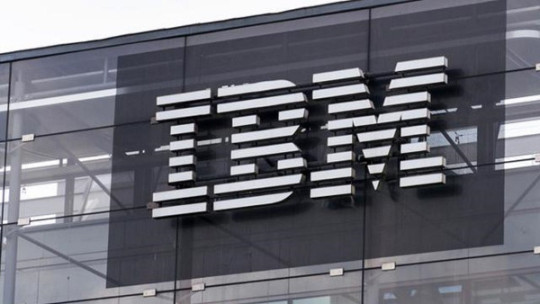#IBM Watsonx
Explore tagged Tumblr posts
Text
IBM compra startup de análise de dados Seek AI e expande centro de IA em Nova York
A IBM anunciou recentemente a aquisição da startup Seek AI, conhecida por sua especialização em análise de dados com inteligência artificial. Esse movimento faz parte da estratégia da IBM de ampliar suas capacidades em IA generativa para negócios. Embora o valor da transação não tenha sido revelado, o impacto dessa compra promete ser significativo. Tornando Dados Corporativos Mais Acessíveis A…
#análise de dados#centro de inovação#IA generativa#IBM Watsonx#inteligência artificial#linguagem natural#tecnologia empresarial#transformação digital
0 notes
Text
IBM y la NASA crean un modelo fundacional de IA geoespacial de código abierto en Hugging Face
Continue reading Untitled

View On WordPress
#Acuerdo de Ley Espacial#AI#Código abierto#Clark University#Clima#Datos geoespaciales#Datos Satelitales#Deforestación#Gases de efecto invernadero#Harmonized Landsat Sentinel-2 satellite data#HLS#Hugging Face#IA#IBM#IBM Environmental Intelligence Suite#IBM Watsonx#Imágenes Satelitales#Iniciativa Científica de Código Abierto#Inteligencia Artificial#Nasa#satélite#watsonx#watsonx.ai
0 notes
Text
IBM’s Strategic Acquisition of Seek AI and the Launch of Watsonx AI Labs in New York City
In a significant move to bolster its position in the artificial intelligence (AI) sector, IBM has acquired Seek AI, a data analysis startup specializing in natural language processing for enterprise data queries. Concurrently, IBM announced the establishment of Watsonx AI Labs, an AI accelerator located in New York City. These initiatives underscore IBM’s commitment to advancing AI technologies and fostering innovation within the enterprise sector.
Understanding Seek AI and Its Innovations
Founded in 2021 by Sarah Nagy, Seek AI has developed a platform that enables users to interact with enterprise data using natural language. This technology allows individuals to pose questions in everyday language, which the system then translates into database queries, facilitating intuitive and efficient data analysis. Seek AI’s solutions have been particularly impactful in sectors such as e-commerce, financial services, and consumer packaged goods, where rapid data insights are crucial for decision-making.
Timeline and Strategic Planning Behind the Acquisition
IBM’s acquisition of Seek AI is part of a broader strategy to enhance its AI capabilities, particularly in natural language processing and data analytics. The planning for this acquisition began in early 2025, with IBM identifying Seek AI’s technology as complementary to its existing AI portfolio. The deal was finalized and publicly announced on June 2, 2025.
Key Figures and Their Roles
The acquisition brings Sarah Nagy, Seek AI’s founder and CEO, into IBM’s fold. Nagy’s expertise in data analytics and AI will be instrumental in integrating Seek AI’s technology into IBM’s offerings. Additionally, Ritika Gunnar, IBM’s General Manager of Data and AI, has been a pivotal figure in orchestrating the launch of Watsonx AI Labs and aligning it with IBM’s strategic objectives.
Significance of the Acquisition and the AI Accelerator
This acquisition is significant for several reasons:
Technological Enhancement: Integrating Seek AI’s natural language processing capabilities enhances IBM’s AI solutions, making them more user-friendly and accessible to enterprise clients.
Market Positioning: By acquiring a startup with innovative technology, IBM strengthens its position in the competitive AI market, particularly in the realm of enterprise data analytics.
Innovation Hub: The establishment of Watsonx AI Labs in New York City positions IBM at the heart of a vibrant tech ecosystem, fostering collaboration and innovation.

Rationale Behind IBM’s Strategic Moves
An AI Lab—short for Artificial Intelligence Laboratory—is a dedicated center for the research, development, and application of AI technologies. These labs are typically operated by universities, tech giants, startups, or public-private partnerships. The goal is to advance the state of artificial intelligence through cutting-edge experiments, model development, ethical testing, and product innovation.
Unlike a regular software development unit, AI labs are innovation-driven, where the focus lies on solving complex problems using machine learning, natural language processing, computer vision, and even robotics. They serve as hubs for technologists, researchers, students, and entrepreneurs to collaborate, ideate, and build the future of intelligent systems.
AI Labs operate at the intersection of technology, business, and academia. Here’s what typically happens within these innovation centers:
1. Pioneering AI Research
The primary mission of most AI Labs is to drive advanced research in areas like deep learning, generative AI, large language models (LLMs), and reinforcement learning. These labs often publish white papers, participate in global AI challenges, and contribute to the open-source AI ecosystem.
Read More : IBM’s Strategic Acquisition of Seek AI and the Launch of Watsonx AI Labs in New York City
#Sure! Here are relevant comma-separated tags for your topic:#**IBM#Seek AI#Watsonx#AI labs#artificial intelligence#tech acquisitions#New York tech#enterprise AI#machine learning#data analytics#IBM Watson#AI innovation#AI research#tech strategy#cloud computing#AI infrastructure**
0 notes
Text
IBM - IBM Unveils watsonx AI Labs: The Ultimate Accelerator for AI Builders, Startups and Enterprises in New York City:
WatsonxAILabs #Watsonx #IBM #NewYork #AgenticAI #DataMining #EnterpriseData #SoftwareEngineering #ArtificialIntelligence #AI #Engineering #ComputerScience #Business
#watsonxailabs#watsonx#ibm#newyork#agenticai#datamining#enterprisedata#softwareengineering#artificialintelligence#ai#engineering#computerscience#business
0 notes
Text
EACOMM named IBM Philippines Rookie Partner of the Year for 2024
0 notes
Text
IBM Unveils Next Chapter of watsonx with Open Source, Product & Ecosystem Innovations to Drive Enterprise AI at Scale
Releases a family of IBM Granite models into open source, including its most capable and efficient Code LLMs that can out-perform larger code models on many industry benchmarks Jointly with Red Hat, launches InstructLab, a first-of-its-kind model alignment technique, to bring open-source community contributions directly into LLMs Unveils new vision and momentum for new data and automation…

View On WordPress
0 notes
Text
Mizuho & IBM Partner on Gen AI PoC to Boost Recovery Times

IBM and Mizuho Financial Group, worked together to create a proof of concept (PoC) that uses IBM’s enterprise generative AI and data platform, watsonx, to increase the effectiveness and precision of Mizuho’s event detection processes.
During a three-month trial, the new technology showed 98% accuracy in monitoring and reacting to problem alerts. Future system expansion and validation are goals shared by IBM and Mizuho.
The financial systems need to recover accurately and quickly after an interruption.
However, operators frequently receive a flood of messages and reports when an error is detected, which makes it challenging to identify the event’s source and ultimately lengthens the recovery period.
In order to solve the problem, IBM and Mizuho carried out a Proof of Concept using Watsonx to increase error detection efficiency.
In order to reduce the number of steps required for recovery and accelerate recovery, the Proof of Concept (PoC) integrated an application that supported a series of processes in event detection with Watsonx and incorporated patterns likely to result in errors in incident response.
By utilising Watsonx, Mizuho was also able to streamline internal operations and enable people on-site to configure monitoring and operating menus in a flexible manner when greater security and secrecy are needed.
In the upcoming year, Mizuho and IBM intend to extend the event detection and reaction proof of concept and integrate it into real-world settings. To increase operational efficiency and sophistication, Mizuho and IBM also intend to cooperate on incident management and advanced failure analysis using generative AI.
WatsonX for Proof of Concept (PoC)
IBM’s WatsonX is an enterprise-grade platform that integrates generative AI capabilities with data. It is therefore an effective tool for creating and evaluating AI solutions. This is a thorough examination of WatsonX use for a PoC:
Why Would a PoC Use WatsonX?
Streamlined Development: WatsonX can expedite the Proof of Concept development process by providing a pre-built component library and an intuitive UI.
Data Integration: It is simpler to include the data required for your AI model since the platform easily integrates with a variety of data sources.
AI Capabilities: WatsonX comes with a number of built-in AI features, including as computer vision, machine learning, and natural language processing, which let you experiment with alternative strategies within your proof of concept.
Scalability: As your solution develops, the platform can handle handling small-scale experimentation for your Proof of Concept.
How to Use a WatsonX PoC
Establish your objective: Clearly state the issue you’re attempting to resolve or the procedure you wish to use AI to enhance. What precise results are you hoping to achieve with your PoC?
Collect Information: Determine the kind of data that your AI model needs to be trained on. Make that the information is adequate, correct, and pertinent for the PoC’s scope.
Select Usability: Based on your objective, choose the WatsonX AI functionalities that are most relevant. Computer vision for image recognition, machine learning for predictive modelling, and natural language processing for sentiment analysis are examples.
Create a PoC: Create a rudimentary AI solution using WatsonX’s tools and frameworks. This could entail building a prototype with restricted functionality or training a basic model.
Test & Assess: Utilise real-world data to evaluate your proof of concept’s efficacy. Examine the outcomes to determine whether the intended goals were met. Point out any places that need work.
Refine and Present: Make iterations to the data, model, or functions to improve your Proof of Concept based on your assessment. Present your results to stakeholders at the end, highlighting the PoC’s shortcomings and areas for future improvement.
Extra Things to Think About
Keep your point of contact (PoC) concentrated on a single issue or task. At this point, don’t try to develop a complete solution.
Success Criteria: Prior to implementation, clearly define your PoC’s success metrics. This may entail cost-cutting, efficiency, or accuracy.
Ethical Considerations: Consider the ethical ramifications of your AI solution as well as any potential biases in your data.
Goal of Collaboration:
Boost Mizuho’s event detection and reaction activities’ precision and efficiency.
Technology Employed:
IBM’s WatsonX is a platform for corporate generative AI and data.
What they Found Out:
Created a proof of concept (PoC) that monitors error signals and reacts with WatsonX.
Over the course of a three-month study, the PoC attained a 98% accuracy rate.
Future Objectives:
Increase the breadth of the event detection and response situations covered by the PoC.
After a year, implement the solution in actual production settings.
To further streamline operations, investigate the use of generative AI for enhanced failure analysis and issue management.
Total Effect:
This project demonstrates how generative AI has the ability to completely transform the banking industry’s operational effectiveness. Mizuho hopes to increase overall business continuity and drastically cut down on recovery times by automating incident detection and reaction.
Emphasis on Event Detection and Response: The goal of the project is to enhance Mizuho’s monitoring and error-messaging processes by employing generative AI, notably IBM’s WatsonX platform.
Effective Proof of Concept (PoC): Mizuho and IBM worked together to create a PoC that showed a notable increase in accuracy. During a three-month trial period, the AI system identified and responded to error notifications with a 98% success rate.
Future Plans: Mizuho and IBM intend to grow the project in the following ways in light of the encouraging Proof of Concept outcomes:
Production Deployment: During the course of the upcoming year, they hope to incorporate the event detection and response system into Mizuho’s live operations environment.
Advanced Applications: Through this partnership, generative AI will be investigated for use in increasingly difficult activities such as advanced failure analysis and incident management. This might entail the AI automatically identifying problems and making recommendations for fixes, therefore expediting the healing procedures.
Overall Impact: This project demonstrates how generative AI has the ability to completely transform financial institutions’ operational efficiency. Mizuho may be able to lower interruption costs, boost overall service quality, and cut downtime by automating fault detection and response.
Consider these other points:
Generative AI can identify and predict flaws by analysing historical data and finding patterns. The calibre and applicability of the data utilised to train the AI models will determine this initiative’s success.
Read more on Govindhtech.com
0 notes
Text
生成式 AI 變球探!西班牙西維爾足球俱樂部率先使用
由 IBM 和西班牙西維爾足球俱樂部(Sevilla FC)日前宣布共同推出一款創新的生成式AI工具Scout Advisor,顧名思義「球探顧問」,西維爾足球俱樂部將使用該工具為其球探團隊提供全面的、數據驅動的潛在新球員識別和評估服務。 西維爾足球俱樂部的 Scout Advisor 以 IBM 專為企業設計的AI與數據平台watsonx構建,將與其現有自主開發的數據密集型應用套件進行整合。 Continue reading 生成式 AI 變球探!西班牙西維爾足球俱樂部率先使用

View On WordPress
0 notes
Link
0 notes
Text
#IA - IBM Planea incluir Llama 2 dentro de Watsonx AI y Data Platform
Como parte del despliegue continuo de su plataforma de IA y Data Platform para empresas, watsonx, IBM planea alojar el modelo de 70 mil millones de parámetros de Llama 2-chat de Meta en watsonx.ai studio, con acceso anticipado y disponible para clientes y socios selectos. Esto se basará en la colaboración de IBM con Meta en innovación abierta para la IA, incluyendo el trabajo con proyectos de…

View On WordPress
0 notes
Text
Juniper and IBM to Simplify Enterprise Network Operations with Next Era of Gen AI innovation
Learn more about Juniper’s Mist AI and IBM watsonx at Mobile World Congress 2025 News Release – Sunnyvale, CA and New York, NY – February 28, 2025 – Juniper Networks (NYSE: JNPR), a leader in secure, AI-Native Networking, and IBM (NYSE: IBM) today announced plans to expand their collaboration around joint sales, marketing and product integration efforts. The companies are expected to integrate…
3 notes
·
View notes
Video
IBM: Let’s create the right AI for your business with watsonx
This commercial came on while I was getting ready for work this morning. It made me stop short and listen. Is that???? Yes. Yes, it is.
#youtube#oscar isaac#when you become so familiar with a person's voice#watson x#commercial voice over#good morning to me
4 notes
·
View notes
Text
Frustrating thing is that Generative AI is taking the place of other natural langauge systems.
Watson as a system built in the pre-generative days to interpret natural language questions as search queries, interrogate its database, and return natural language answers. They tested in by having it play Jeopardy.
youtube
It wasn't 100% correct, but it didn't have to be. It's goal was to be an assistant- to provide the most likely answers based on degree of confidence. Acting as a starting point or aid rather than the final point of call.
Now Watson has been replaced by watsonx- a system which conglomerates and manages multiple generative AI LLMs.
We're losing one of the longest running and most successful natural language processors in favour of generative AI.
people are really fucking clueless about generative ai huh? you should absolutely not be using it for any sort of fact checking no matter how convenient. it does not operate in a way that guarantees factual information. its goal is not to deliver you the truth but deliver something coherent based on a given data set which may or may not include factual information. both the idolization of ai and fearmongering of it seem lost on what it is actually capable of doing
49K notes
·
View notes
Text
Magistral: Mistral AI challenges big tech with reasoning model
New Post has been published on https://thedigitalinsider.com/magistral-mistral-ai-challenges-big-tech-with-reasoning-model/
Magistral: Mistral AI challenges big tech with reasoning model
Mistral AI has pulled back the curtain on Magistral, their first model specifically built for reasoning tasks.
Magistral arrives in two flavours: a 24B parameter open-source version called Magistral Small that anyone can tinker with, and a beefier enterprise edition, Magistral Medium, aimed at commercial applications where advanced reasoning capabilities matter most.
“The best human thinking isn’t linear—it weaves through logic, insight, uncertainty, and discovery,” explains Mistral AI.
That’s a fair point, existing models often struggle with the messy, non-linear way humans actually think through problems. I’ve tested numerous reasoning models and they typically suffer from three key limitations: they lack depth in specialised domains, their thinking process is frustratingly opaque, and they perform inconsistently across different languages.
Mistral AI’s real-world reasoning for professionals
For professionals who’ve been hesitant to trust AI with complex tasks, Magistral might change some minds.
Legal eagles, finance folks, healthcare professionals and government workers will appreciate the model’s ability to show its work. All conclusions can be traced back through logical steps—crucial when you’re operating in regulated environments where “because the AI said so” simply doesn’t cut it.
Software developers haven’t been forgotten either. Magistral claims to shine at the kind of structured thinking that makes for better project planning, architecture design, and data engineering. Having struggled with some models that produce plausible-sounding but flawed technical solutions, I’m keen to see if Magistral’s reasoning capabilities deliver on this front.
Mistral claims their reasoning model excels at creative tasks too. The company reports that Magistral is “an excellent creative companion” for writing and storytelling, capable of producing both coherent narratives and – when called for – more experimental content. This versatility suggests we’re moving beyond the era of having separate models for creative versus logical tasks.
What separates Magistral from the rest?
What separates Magistral from run-of-the-mill language models is transparency. Rather than simply spitting out answers from a black box, it reveals its thinking process in a way users can follow and verify.
This matters enormously in professional contexts. A lawyer doesn’t just want a contract clause suggestion; they need to understand the legal reasoning behind it. A doctor can’t blindly trust a diagnostic suggestion without seeing the clinical logic. By making its reasoning traceable, Magistral could help bridge the trust gap that’s held back AI adoption in high-stakes fields.
Having spoken with non-English AI developers, I’ve heard consistent frustration about how reasoning capabilities drop off dramatically outside English. Magistral appears to tackle this head-on with robust multilingual support, allowing professionals to reason in their preferred language without performance penalties.
This isn’t just about convenience; it’s about equity and access. As countries increasingly implement AI regulations requiring localised solutions, tools that reason effectively across languages will have a significant advantage over English-centric competitors.
[embedded content]
Getting your hands on Magistral
For those wanting to experiment, Magistral Small is available now under the Apache 2.0 licence via Hugging Face. Those interested in the more powerful Medium version can test a preview through Mistral’s Le Chat interface or via their API platform.
[embedded content]
Enterprise users looking for deployment options can find Magistral Medium on Amazon SageMaker, with IBM WatsonX, Azure, and Google Cloud Marketplace implementations coming soon.
As the initial excitement around general-purpose chatbots begins to wane, the market is hungry for specialised AI tools that excel at specific professional tasks. By focusing on transparent reasoning for domain experts, Mistral has carved out a potentially valuable niche.
Founded just last year by alumni from DeepMind and Meta AI, Mistral has moved at breakneck speed to establish itself as Europe’s AI champion. They’ve consistently punched above their weight, creating models that compete with offerings from companies many times their size.
As organisations increasingly demand AI that can explain itself – particularly in Europe where the AI Act will require transparency – Magistral’s focus on showing its reasoning process feels particularly timely.
(Image by Stephane)
See also: Tackling hallucinations: MIT spinout teaches AI to admit when it’s clueless
Want to learn more about AI and big data from industry leaders? Check out AI & Big Data Expo taking place in Amsterdam, California, and London. The comprehensive event is co-located with other leading events including Intelligent Automation Conference, BlockX, Digital Transformation Week, and Cyber Security & Cloud Expo.
Explore other upcoming enterprise technology events and webinars powered by TechForge here.
#adoption#ai#ai & big data expo#ai act#AI adoption#ai tools#Amazon#amp#Apache#API#applications#architecture#Artificial Intelligence#automation#azure#Big Data#BIG TECH#black box#box#bridge#california#change#chatbots#clinical#Cloud#Companies#comprehensive#conference#content#cyber
0 notes
Text
10 Game-Changing AI Tools Driving Business Innovation in 2025
In 2025, AI tools are altering business operations instead of simply improving them; there are transformations taking place. As the fields of machine learning, automation, and data processing advance rapidly, companies from every industry are incorporating artificial intelligence for business in a way they never have before. These tools are allowing businesses to remain competitive, innovate quicker, and deliver better experiences to their customers.

Here are 10 AI tools in 2025 making an impact in business and producing deep business innovation.
1. ChatGPT for Enterprise
AI content generation is revolutionizing content generation. ChatGPT Enterprise is transforming knowledge management, client support, and productivity. It is taking use of automatic language generation.
Why it’s Innovative:
Automates client communications
Increases employee productivity
Adapted for business flows
2. Jasper AI
Jasper AI has empowered marketing teams to develop high-converting content within seconds with its advanced deep learning models to customize and personalize content created for ads, blogs, and social media.
Benefits of Jasper:
Uniform brand voice
Fast content creation
SEO and conversion boost
3. Sana AI
Sana has a smart onboarding and internal knowledge platform that uses AI to create and recommend learning content.
Why Companies Love It:
AI-generated knowledge hubs
Adaptive learning
Invisible productivity increase for your team
4. Fireflies.ai
A meeting assistant that uses AI to record, transcribe and summarize meetings. A meeting assistant using AI may also be very useful for sales and project teams.
Impact:
Improved communication
Better documentation of meetings
Time-saving summaries
5. UiPath
UiPath is a leader in Robotic Process Automation (RPA). It uses software robots to help businesses automate repetitive work such as invoicing, payroll, and data migration.
Key Features:
Automates workflows
Integrates with enterprise tools
Reduces operational costs
6. Synthesia
Synthesia lets you create AI-generated video with virtual avatars for a wide variety of business purposes - from HR onboarding and customer service training to marketing.
How It Innovates:
No cameras or studio needed
AI avatars humanize communication
7. Notion AI
Notion AI enhances productivity and project collaboration by offering intelligent writing and task suggestions directly inside Notion docs.
What It Does:
Smart writing assistant
Task automation
AI-powered notes and meeting recaps
8. Pega Systems
Pega’s AI platform is used in CRM and decision automation. It empowers real-time customer interaction management, especially in banking and insurance.
Why It’s a Game Changer:
Adaptive AI decisioning
Real-time personalization
Scalable across departments
9. IBM WatsonX
WatsonX offers a full stack AI and data platform. It enables businesses to train, tune, and deploy AI models responsibly at scale.
Benefits for Businesses:
Advanced data analytics
AI model governance
Customizable for industries
10. Zoho Zia
Zia is Zoho CRM’s built-in AI assistant that helps with lead prediction, email sentiment analysis, and task automation.
Why It’s Powerful:
Business insights from data
Intelligent automation
Customer engagement boosts
Final Thoughts
As we move further into 2025, the integration of AI tools is not optional — it’s essential. From automating tedious tasks to delivering personalized experiences, artificial intelligence for business is unlocking a new era of business innovation.
Embracing these technologies today means staying ahead tomorrow. Whether you’re a startup or an enterprise, integrating these AI tools of 2025 can drastically improve how you work, serve customers, and grow.
Want help with implementing AI in your business? Get in touch with Appson Technologies to start your transformation journey today!
Original Source: bit.ly/4kMSXYg
0 notes